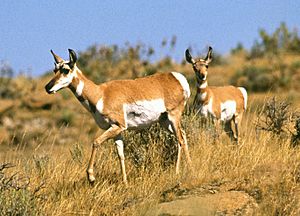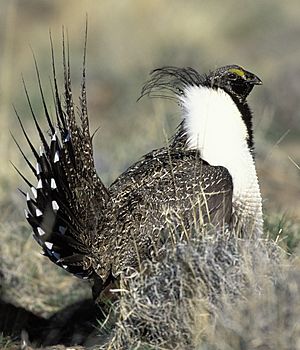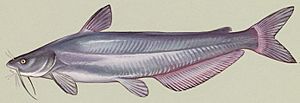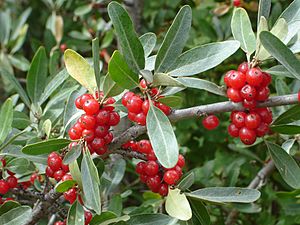List of species described by the Lewis and Clark Expedition facts for kids
Meriwether Lewis was a famous explorer who traveled across North America with the Lewis and Clark Expedition. During his journey, he collected many hundreds of plants. Sadly, many of these plant collections were lost. For example, some plants he collected early on were hidden near the Missouri River, but floods washed them away. Today, we only have 237 of the plants Lewis collected. Most of these, 226, are kept safe in a special collection called the Philadelphia Herbarium. Lewis even hired a scientist named Frederick Pursh to describe 124 of his plant discoveries, and Pursh published his findings in 1814.
Contents
Animals Discovered by Lewis and Clark
The Lewis and Clark Expedition helped scientists learn about many new animals. Some animals were seen for the first time by European Americans. Others were already known but were carefully described by the explorers.
Mammals of the American West
The expedition discovered several mammals that were new to European American scientists. They also carefully described many others.
- Mammals Discovered (New to European Americans):
- Mammals Described:
- American badger (Taxidea taxus)
- American beaver (Castor canadensis)
- Badlands bighorn sheep (Ovis canadensis auduboni)
- Bison (Bison bison)
- Black bear (Ursus americanus)
- Columbian black-tailed deer (Odocoileus hemionus columbianus)
- Columbian ground squirrel (Spermophilus columbianus)
- Coyote (Canis latrans)
- Eastern cottontail (Sylvilagus floridanus)
- Eastern fox squirrel (Sciurus niger)
- Elk (Cervus canadensis)
- Eastern gray squirrel (Sciurus carolinensis)
- Gray wolf (Canis lupus)
- Long-tailed weasel (Mustela frenata)
- Muskrat (Fiber zibethicus)
- Mountain lion (Puma concolor)
- North American river otter (Lontra canadensis)
- Northern pocket gopher (Thomomys talpoides)
- Northern short-tailed shrew (Blarina brevicauda)
- Porcupine (Erethizon dorsatum)
- Red fox (Vulpes vulpes)
- Richardson's ground squirrel or flickertail (Spermophilus richardsonii)
- Striped skunk (Mephitis mephitis)
- Thirteen-lined ground squirrel (Spermophilus tridecemlineatus)
- White-tailed deer (Odocoileus virginianus)
Birds of the Journey
The expedition also found and described many different kinds of birds.
- Birds Discovered (New to European Americans):
- Birds Described:
- American crow (Corvus brachyrhynchos)
- American goldfinch (Carduelis tristis)
- American kestrel (Falco sparverius)
- American robin (Turdus migratorius)
- American white pelican (Pelecanus erythrorhynchos)
- Bald eagle (Haliaeetus leucocephalus)
- Bank swallow (Riparia riparia)
- Belted kingfisher (Ceryle alcyon)
- Black-bellied plover (Pluvialis squatarola)
- Blue grouse (Dendragapus obscurus)
- Blue jay (Cyanocitta cristata)
- Brewer's blackbird (Euphagus cyanocephalus)
- Brown-headed cowbird (Molothrus ater)
- Canada goose (Branta canadensis)
- Carolina parakeet (Conuropsis carolinensis)
- Cedar waxwing (Bombycilla cedrorum)
- Cliff swallow (Hirundo pyrrhonota or Petrochelidon pyrrhonota)
- Piping Plover (Charadrius melodus)
- Columbian sharp-tailed grouse (Tympanuchus phasianellus columbianus)
- Common Nighthawk (Chordeiles minor)
- Common raven (Corvus corax)
- Eastern kingbird (Tyrannus tyrannus)
- Great blue heron (Ardea herodias)
- Great egret (Ardea alba)
- Greater prairie-chicken (Tympanuchus cupido pinnatus)
- Golden eagle (Aquila chrysaetos)
- Great horned owl (Bubo virginianus)
- Hairy woodpecker (Picoides villosus)
- Horned lark (Eremophila alpestris)
- Killdeer (Charadrius vociferus)
- Lark sparrow (Chondestes grammacus)
- Loggerhead shrike (Lanius ludovicianus)
- Long-billed curlew (Numenius americanus)
- Mallard (Anas platyrhynchos)
- Merganser (Mergus serrator)
- Mourning dove (Zenaida macroura)
- Northern flicker (Colaptes auratus)
- Northern harrier (Circus cyaneus) - tentative
- Osprey (Pandion haliaetus)
- Passenger pigeon (Ectopistes migratorius)
- Pinyon jay (Gymnorhinus cyanocephalus)
- Piping plover (Charadrius melodus)
- Plains sharp-tailed grouse (Tympanuchus phasianellus jamesi)
- Red-headed woodpecker (Melanerpus erythrocephalus)
- Red-tailed hawk (Buteo jamaicensis)
- Red-winged blackbird (Agelaius phoeniceus)
- Ruffed grouse (Bonasa umbellus)
- Sandhill crane (Grus canadensis)
- Snow goose (Chen caerulescens)
- Sprague's pipit (Anthus spragueii)
- Upland sandpiper (Bartramia longicauda)
- Western meadowlark (Sturnella neglecta)
- Whip-poor-will (Caprimulgus vociferus)
- Whooping crane (Grus americana)
- Wild turkey (Meleagris gallopavo)
- Willet (Catoptrophorus semipalmatus)
- Wood duck (Aix sponsa)
Amphibians Encountered
The expedition also recorded several amphibians, which are animals that can live both on land and in water.
- Amphibians Described:
- Chorus frog (Pseudacris triseriata)
- Green frog (Rana clamitans)
- Green tree frog (Hyla)
- Western toad (Anaxyrus boreas)
Reptiles Observed
Reptiles like snakes and lizards were also part of the discoveries made by Lewis and Clark.
- Reptiles Described:
Fish of the Rivers
The explorers also documented many fish species found in the rivers and waterways they traveled.
- Fish Discovered (New to European Americans):
- Blue catfish (Ictalurus furcatus)
- Channel catfish (Ictalurus punctatus)
- Goldeye (Hiodon alosoides)
- Mountain whitefish (Prosopium williamsoni)
- White sturgeon (Acipenser transmontanus)
- Fish Described:
- Cutthroat trout (Oncorhynchus clarki)
- Westslope cutthroat trout (O. c. lewisi)
- Coastal cutthroat trout (O. c. clarki)
- Common northern sucker (Catostomus catostomus)
- Sauger (Stizostedion canadensis)
Plants Collected by Lewis
Meriwether Lewis collected many different types of plants during his expedition. Some of these plants were completely new to science, while others had been seen before but were important discoveries for the expedition.
- Plants Discovered (New to European Americans):
- Black greasewood (Sarcobatus vermiculatus)
- Blue flax (Linum lewisii)
- Buffaloberry (Shepherdia argentea)
- Curly-top gumweed (Grindelia squarrosa)
- Fringed sagebrush (Artemisia ludoviciana)
- Indian tobacco (Nicotiana quadrivalvis)
- Lanceleaf sage (Salvia reflexa)
- Shadscale (Atriplex canescens)
- Snow-on-the-mountain (Euphorbia marginata)
- White milkwort (Polygala alba)
- Aromatic aster (Aster oblongifolius)
- Aromatic sumac also called squaw bush (Rhus aromatica)
- Bearberry also called kinnikinnick (Arctostaphylos uva-ursi)
- Bur oak (Quercus macrocarpa)
- Broom snakeweed (Gutierrezia sarothrae)
- Canada milk-vetch (Astragalus canadensis)
- Common horsetail, also called scouring rush (Equisetum arvense)
- Common juniper (Juniperus communis)
- Common monkey-flower (Mimulus guttatus)
- Creeping juniper (Juniperus horizontalis)
- Dwarf sagebrush (Artemisia cana)
- Eastern cottonwood (Populus deltoides)
- False indigo (Amorpha fruticosa)
- Fire-on-the-mountain (Euphorbia cyathophora)
- Golden currant (Ribes aureum)
- Large-flowered clammyweed (Polanisia dodecandra trachysperma)
- Long-leaved sagebrush also called mugwort (Artemisia longifolia)
- Meadow anemone (Anemone canadensis)
- Missouri milk-vetch (Astragalus missouriensis)
- Moundscale (Atriplex gardneri)
- Needle-and-thread grass also called porcupine grass (Hesperostipa comata)
- Pasture sagewort (Artemisia frigida)
- Pin cherry (Prunus pennsylvanica)
- Ponderosa pine (Pinus ponderosa)
- Purple coneflower (Echinacea angustifolia)
- Purple prairie-clover (Petalostemon purpurea or Dalea purpurea)
- Rabbitbrush (Ericameria nauseosa; formerly Chrysothamnus nauseosus)
- Raccoon grape (Ampelopsis cordata)
- Rigid goldenrod (Solidago rigida)
- Rocky Mountain beeplant (Cleome serrulata)
- Rough gayfeather also called large button snakeroot (Liatris aspera)
- Silky wormwood (Artemisia dracunculus)
- Spiny goldenweed (Machaeranthera pinnatifida or Haplopappus spinulosus)
- Thick-spike gayfeather also called prairie button snakeroot (Liatris pycnostachya)
- Western red cedar also called Rocky Mountain juniper (Juniperus scopulorum)
- Wild four-o'clock (Mirabilis nyctaginea)
- Wild rice (Zizania palustris)
- Wild rose (Rosa arkansana)





